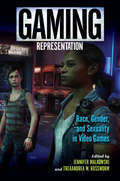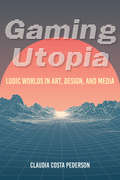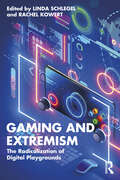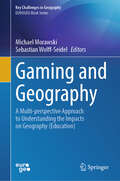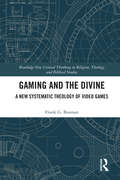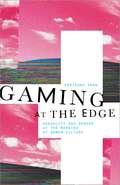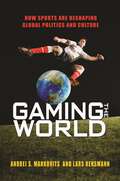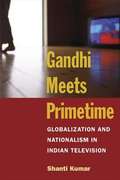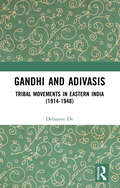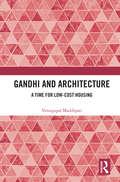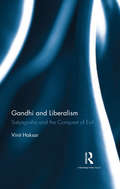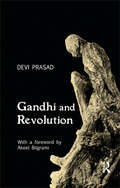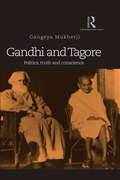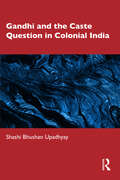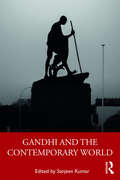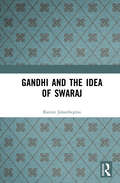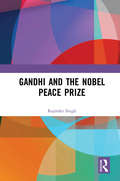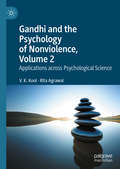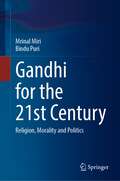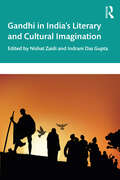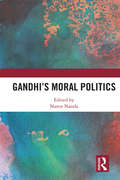- Table View
- List View
Gaming Representation: Race, Gender, and Sexuality in Video Games
by Treaandrea M. Russworm Jennifer MalkowskiRecent years have seen an increase in public attention to identity and representation in video games, including journalists and bloggers holding the digital game industry accountable for the discrimination routinely endured by female gamers, queer gamers, and gamers of color. Video game developers are responding to these critiques, but scholarly discussion of representation in games has lagged far behind. Gaming Representation examines portrayals of race, gender, and sexuality in a range of games, from casuals like Diner Dash, to indies like Journey and The Binding of Isaac, to mainstream games from the Grand Theft Auto, BioShock, Spec Ops, The Last of Us, and Max Payne franchises. Arguing that representation and identity function as systems in games that share a stronger connection to code and platforms than it may first appear, the contributors to this volume push gaming scholarship to new levels of inquiry, theorizing, and imagination.
Gaming Sexism: Gender and Identity in the Era of Casual Video Games
by Amanda C. CoteInterviews with female gamers about structural sexism across the gaming landscapeWhen the Nintendo Wii was released in 2006, it ushered forward a new era of casual gaming in which video games appealed to not just the stereotypical hardcore male gamer, but also to a much broader, more diverse audience. However, the GamerGate controversy six years later, and other similar public incidents since, laid bare the internalized misogyny and gender stereotypes in the gaming community. Today, even as women make up nearly half of all gamers, sexist assumptions about the what and how of women’s gaming are more actively enforced.In Gaming Sexism, Amanda C. Cote explores the video game industry and its players to explain this contradiction, how it affects female gamers, and what it means in terms of power and gender equality. Across in-depth interviews with women-identified gamers, Cote delves into the conflict between diversification and resistance to understand their impact on gaming, both casual and “core” alike. From video game magazines to male reactions to female opponents, she explores the shifting expectations about who gamers are, perceived changes in gaming spaces, and the experiences of female gamers amidst this gendered turmoil. While Cote reveals extensive, persistent problems in gaming spaces, she also emphasizes the power of this motivated, marginalized audience, and draws on their experiences to explore how structural inequalities in gaming spaces can be overcome. Gaming Sexism is a well-timed investigation of equality, power, and control over the future of technology.
Gaming Utopia: Ludic Worlds in Art, Design, and Media
by Claudia Costa PedersonIn Gaming Utopia: Ludic Worlds in Art, Design, and Media, Claudia Costa Pederson analyzes modernist avant-garde and contemporary video games to challenge the idea that gaming is an exclusively white, heterosexual, male, corporatized leisure activity and reenvisions it as a catalyst for social change. By looking at over fifty projects that together span a century and the world, Pederson explores the capacity for sociopolitical commentary in virtual and digital realms and highlights contributions to the history of gaming by women, queer, and transnational artists. The result is a critical tool for understanding video games as imaginative forms of living that offer alternatives to our current reality. With an interdisciplinary approach, Gaming Utopia emphasizes how game design, creation, and play can become political forms of social protest and examines the ways that games as art open doors to a more just and peaceful world.
Gaming and Extremism: The Radicalization of Digital Playgrounds
by Rachel Kowert Linda SchlegelCharting the increase in the use of games for the dissemination of extremist propaganda, radicalization, recruitment, and mobilization, this book examines the "gamification of extremism."Editors Linda Schlegel and Rachel Kowert bring together a range of insights from world-leading experts in the field to provide the first comprehensive overview of gaming and extremism. The potential nexus between gaming and extremism has become a key area of concern for researchers, policymakers, and practitioners seeking to prevent and counter radicalization and this book offers insights into key trends and debates, future directions, and potential prevention efforts. This includes the exploration of how games and game adjacent spaces, such as Discord, Twitch, Steam, and DLive, are being leveraged by extremists for the purposes of radicalization, recruitment, and mobilization. Additionally, the book presents the latest counterterrorism techniques, surveys promising preventing/countering violent extremism (P/CVE) measures currently being utilized in the gaming sphere, and examines the ongoing challenges, controversies, and current gaps in knowledge in the field.This text will be of interest to students and scholars of gaming and gaming culture, as well as an essential resource for researchers and practitioners working in prevention and counter-extremism, professionals working at gaming-related tech companies, and policymakers.The Open Access version of this book, available at www.taylorfrancis.com, has been made available under a Creative Commons Attribution-Non Commercial-No Derivatives 4.0 license.
Gaming and Geography: A Multi-perspective Approach to Understanding the Impacts on Geography (Education) (Key Challenges in Geography)
by Michael Morawski Sebastian Wolff-SeidelThis book explores the uncharted territory where gaming and geography intersect in "Gaming and Geography (Education)." This book bridges the gap between video games and geography, delving into the constructivist creative processes of game development, gameplay, and critical reflections on video games' role in geographical discourses. Through a multi-perspective lens, the book examines how video games can facilitate the exploration of geographic questions and act as catalysts for critical discourses. Scholars shed light on the geographies presented in video games, including their representations, spatial images, and policies. By viewing video games as cultural and critical geography practices, the authors enrich the political, socio-cultural, and critical geographies associated with this medium. A key argument of the book is that video games can foster systemic competence and networked thinking, particularly in addressing complex socio-ecological challenges like climate change and migration. In contrast to traditional geography classes, digital games provide valuable simulations of complex systems, enhancing students' understanding and skills. The book also explores other possibilities such as digital field trips and language support to enhance the educational experience. "Gaming and Geography (Education)" offers a compelling narrative that highlights the diverse roles video games can play in geographic education. By exploring the intersection of gaming and geography, this book deepens our understanding of this dynamic relationship and its impact on critical geographies within the realm of video games.
Gaming and the Divine: A New Systematic Theology of Video Games (Routledge New Critical Thinking in Religion, Theology and Biblical Studies)
by Frank G. BosmanThis book formulates a new theological approach to the study of religion in gaming. Video games have become one of the most important cultural artifacts of modern society, both as mediators of cultural, social, and religious values and in terms of commercial success. This has led to a significant increase in the critical analysis of this relatively new medium, but theology as an academic discipline is noticeably behind the other humanities on this subject. The book first covers the fundamentals of cultural theology and video games. It then moves on to set out a Christian systematic theology of gaming, focusing on creational theology, Christology, anthropology, evil, moral theology, and thanatology. Each chapter introduces case studies from video games connected to the specific theme. In contrast to many studies which focus on online multiplayer games, the examples considered are largely single player games with distinct narratives and ‘end of game’ moments. The book concludes by synthesizing these themes into a new theology of video games. This study addresses a significant aspect of contemporary society that has yet to be discussed in any depth by theologians. It is, therefore, a fantastic resource for any scholar engaging with the religious aspects of digital and popular culture.
Gaming at the Edge: Sexuality and Gender at the Margins of Gamer Culture
by Adrienne ShawVideo games have long been seen as the exclusive territory of young, heterosexual white males. In a media landscape dominated by such gamers, players who do not fit this mold, including women, people of color, and LGBT people, are often brutalized in forums and in public channels in online play. Discussion of representation of such groups in games has frequently been limited and cursory. In contrast, Gaming at the Edge builds on feminist, queer, and postcolonial theories of identity and draws on qualitative audience research methods to make sense of how representation comes to matter. In Gaming at the Edge, Adrienne Shaw argues that video game players experience race, gender, and sexuality concurrently. She asks: How do players identify with characters? How do they separate identification and interactivity? What is the role of fantasy in representation? What is the importance of understanding market logic? In addressing these questions Shaw reveals how representation comes to matter to participants and offers a perceptive consideration of the high stakes in politics of representation debates. Putting forth a framework for talking about representation, difference, and diversity in an era in which user-generated content, individualized media consumption, and the blurring of producer/consumer roles has lessened the utility of traditional models of media representation analysis, Shaw finds new insight on the edge of media consumption with the invisible, marginalized gamers who are surprising in both their numbers and their influence in mainstream gamer culture.
Gaming the Dynamics of Online Harassment: Crowdsourced Terrorism
by Kevin VealeThis book argues that online harassment communities function as Alternate Reality Games (ARGs) where the collective goal is to ruin peoples’ lives. Framing these communities like ARGs highlights ways to limit their impact in the future, partly through offering people better ways to control their own safety online.The comparison also underlines the complicity of social networks in online harassment, since the communities use their designs as tools. Social networks know this, and need to work on minimizing the problem, or acknowledge that they are profiting through promoting abuse.
Gaming the World: How Sports Are Reshaping Global Politics and Culture
by Andrei S. Markovits Lars RensmannThe globalizing influence of professional sportsProfessional sports today have truly become a global force, a common language that anyone, regardless of their nationality, can understand. Yet sports also remain distinctly local, with regional teams and the fiercely loyal local fans that follow them. This book examines the twenty-first-century phenomenon of global sports, in which professional teams and their players have become agents of globalization while at the same time fostering deep-seated and antagonistic local allegiances and spawning new forms of cultural conflict and prejudice.Andrei Markovits and Lars Rensmann take readers into the exciting global sports scene, showing how soccer, football, baseball, basketball, and hockey have given rise to a collective identity among millions of predominantly male fans in the United States, Europe, and around the rest of the world. They trace how these global—and globalizing—sports emerged from local pastimes in America, Britain, and Canada over the course of the twentieth century, and how regionalism continues to exert its divisive influence in new and potentially explosive ways. Markovits and Rensmann explore the complex interplay between the global and the local in sports today, demonstrating how sports have opened new avenues for dialogue and shared interest internationally even as they reinforce old antagonisms and create new ones.Gaming the World reveals the pervasive influence of sports on our daily lives, making all of us citizens of an increasingly cosmopolitan world while affirming our local, regional, and national identities.
Gaming: Essays On Algorithmic Culture (Electronic Mediations #18)
by Alexander R. GallowayVideo games have been a central feature of the cultural landscape for over twenty years and now rival older media like movies, television, and music in popularity and cultural influence. Yet there have been relatively few attempts to understand the video game as an independent medium. Most such efforts focus on the earliest generation of text-based adventures (Zork, for example) and have little to say about such visually and conceptually sophisticated games as Final Fantasy X, Shenmue, Grand Theft Auto, Halo, and The Sims, in which players inhabit elaborately detailed worlds and manipulate digital avatars with a vast—and in some cases, almost unlimited—array of actions and choices. In Gaming, Alexander Galloway instead considers the video game as a distinct cultural form that demands a new and unique interpretive framework. Drawing on a wide range of disciplines, particularly critical theory and media studies, he analyzes video games as something to be played rather than as texts to be read, and traces in five concise chapters how the &“algorithmic culture&” created by video games intersects with theories of visuality, realism, allegory, and the avant-garde. If photographs are images and films are moving images, then, Galloway asserts, video games are best defined as actions. Using examples from more than fifty video games, Galloway constructs a classification system of action in video games, incorporating standard elements of gameplay as well as software crashes, network lags, and the use of cheats and game hacks. In subsequent chapters, he explores the overlap between the conventions of film and video games, the political and cultural implications of gaming practices, the visual environment of video games, and the status of games as an emerging cultural form. Together, these essays offer a new conception of gaming and, more broadly, of electronic culture as a whole, one that celebrates and does not lament the qualities of the digital age. Alexander R. Galloway is assistant professor of culture and communication at New York University and author of Protocol: How Control Exists after Decentralization.
Gandhi Meets Primetime: Globalization and Nationalism in Indian Television
by Shanti KumarInspired new translations of the work of one of the world's greatest fabulists Told in an elegant style, Jean de la Fontaine's (1621-95) charming animal fables depict sly foxes and scheming cats, vain birds and greedy wolves, all of which subtly express his penetrating insights into French society and the beasts found in all of us. Norman R. Shapiro has been translating La Fontaine's fables for over twenty years, capturing the original work's lively mix of plain and archaic language. This newly complete translation is destined to set the English standard for this work. Awarded the Lewis Galantière Prize by the American Translators Association, 2008.
Gandhi and Adivasis: Tribal Movements in Eastern India (1914-1948)
by Debasree DeAdivasi movements played a very important, if not determining, role in the India’s freedom struggle. Gandhi’s idea of mass mobilization couldn’t have been successful without the active participation of all sections of the Indian society. Adivasi movements were swelled by Gandhian ideology only during the Non-Cooperation movement. Though Gandhi’s interest in the tribal problems crystallized at a later stage of his life, his influence on tribal movements was revealing. His association with Thakkar Bapa and Verrier Elwin also enriched his knowledge about tribal state of affairs. Adivasis started looking at Gandhi as saviour or a saint, who could deliver them justice and peace. But, Gandhi always supported Adivasi movements in order to give a mass character to his movements. There were some particular demands of the Adivasis that were not supported by Gandhi. Their armed struggle was also against his non-violent principles. During the latter half of the twentieth century, movements like Tana Bhagat and Hari Baba were purely influenced by the Gandhian ideology, but failed to achieve their goals. Later on, the Jharkhand movement adopted the character of a non-violent struggle; here also the fruits disappeared. The present work focuses on the first three movements of the Chota Nagpur Plateau of eastern India during Gandhi’s lifetime and the current movements against forceful displacement by POSCO, Vedanta and others, in order to comprehend his ideological impact on Adivasi movements of today. The book has critically analysed and evaluated Gandhi’s impact on the Adivasi situation in colonial and post-colonial India. Please note: Taylor & Francis does not sell or distribute print edition in India, Pakistan, Nepal, Bhutan, Bangladesh and Sri Lanka.
Gandhi and Architecture: A Time for Low-Cost Housing
by Venugopal MaddipatiGandhi and Architecture: A Time for Low-Cost Housing chronicles the emergence of a low-cost, low-rise housing architecture that conforms to M.K. Gandhi’s religious need to establish finite boundaries for everyday actions; finitude in turn defines Gandhi’s conservative and exclusionary conception of religion. Drawing from rich archival and field materials, the book begins with an exploration of Gandhi’s religiosity of relinquishment and the British Spiritualist, Madeline Slade’s creation of his low-cost hut, Adi Niwas, in the village of Segaon in the 1930s. Adi Niwas inaugurates a low-cost housing architecture of finitude founded on the near-simultaneous but heterogeneous, conservative Gandhian ideals of pursuing self-sacrifice and rendering the pursuit of self-sacrifice legible as the practice of an exclusionary varnashramadharma. At a considerable remove from Gandhi’s religious conservatism, successive generations in post-colonial India have reimagined a secular necessity for this Gandhian low-cost housing architecture of finitude. In the early 1950s era of mass housing for post-partition refugees from Pakistan, the making of a low-cost housing architecture was premised on the necessity of responding to economic concerns and to an emerging demographic mandate. In the 1970s, during the Organization of Petroleum Exporting Countries crisis, it was premised on the rise of urban and climatological necessities. More recently, in the late 1990s and early 2000s, its reception has been premised on the emergence of language-based identitarianism in Wardha, Maharashtra. Each of these moments of necessity reveals the enduring present of a Gandhian low-cost housing architecture of finitude and also the need to emancipate Gandhian finitude from Gandhi’s own exclusions. This volume is a critical intervention in the philosophy of architectural history. Drawing eclectically from science and technology studies, political science, housing studies, urban studies, religious studies, and anthropology, this richly illustrated volume will be of great interest to students and researchers of architecture and design, housing, history, sociology, economics, Gandhian studies, urban studies and development studies.
Gandhi and Liberalism: Satyagraha and the Conquest of Evil
by Vinit HaksarOne of the main themes running through Gandhi’s life and work was the battle against evil. This book offers a fascinating reconstruction of Gandhi and the doctrine of Ahimsa or non-violence. Gandhi’s moral perfectionism is contrasted with other forms of perfectionism, but the book stresses that Gandhi also offered a doctrine of the second best. Following Gandhi, the author argues that outward violence with compassion is intrinsically not as good as non-violence with compassion, but it is a second best that is sometimes a necessary evil in an imperfect world. The book provides an illuminating analysis of coercion, non-co-operation, civil disobedience and necessary evil, comparing Gandhi’s ideas with that of some of the leading western moral, legal and political philosophers. Further, some of his important ideas are shown to have relevance for the working of the Indian Constitution. This book will be essential for scholars and researchers in moral, legal and political philosophy, Gandhi studies, political science and South Asian studies.
Gandhi and Revolution
by Devi PrasadThis volume is a collection of Devi Prasad’s essays on Gandhi, social justice and social change. The different essays address themes ranging from Gandhi’s ideals of satyagraha and ahimsa, civil disobedience and non-violence, to the Gandhian approach to education as founded in making and crafting as well as participation in the political and social movements of our times. They also engage the revolutionary potential of Gandhi’s thought, drawing parallels between Lenin and Gandhi and analysing the historical significance of Gandhi’s anti-imperialist yet non-violent political philosophy. In sum, the volume dwells on the continuing, critical relevance of Gandhi in our times. It will be of interest to those in education, political science, peace and conflict studies, history and philosophy, as well as to the general reader interested in Gandhian thought.
Gandhi and Tagore: Politics, truth and conscience
by Gangeya MukherjiThis book brings together the political thought of Gandhi and Tagore to examine the relationship between politics, truth and conscience. It explores truth and conscience as viable public virtues with regard to two exemplars of ethical politics, addressing in turn the concerns of an evolving modern Indian political community. <P><P>The comprehensive and textually argued discussion frames the subject of the validity of ethical politics in inhospitable contexts such as the fanatically despotic state and energised nationalism. The book studies in nuanced detail Tagore’s opposition to political violence in colonial Bengal, the scope of non-violence and satyagraha as recommended by Gandhi to Jews in Nazi Germany, his response to the complexity of protest against the Jallianwala Bagh massacre, and the differently constituted nationalism of Gandhi and Tagore. It presents their famous debate in a new light, embedded within the dynamics of cultural identification, political praxis and the capacity of a community to imbibe the principles of ethical politics. Comprehensive and perceptive in analysis, this book will be a valuable addition for scholars and researchers of political science with specialisation in Indian political thought, philosophy and history. <P><P>Gangeya Mukherji is Reader in English at Mahamati Prannath Mahavidyalaya, Mau-Chitrakoot, Uttar Pradesh, India.
Gandhi and the Caste Question in Colonial India
by Shashi Bhushan UpadhyayThis book comprehensively surveys and critically analyses Gandhi’s ideas on caste and untouchability. It emphasizes the fact that Gandhi was a considerable thinker who had seminal ideas on the caste question. As an intellectual history, this book is not just a study of his ideas but also of what he practised. It narrates his lifelong struggle against untouchability since his South African days and focuses on his distinctive understanding of the caste question which differed sharply from that of his contemporaries both on the right and the left.The book also critically analyses and questions the attribution of strategy to Gandhi with regard to both the nationalist and anti-untouchability movements. The volume will be of great interest to scholars and researchers of history, caste and discrimination studies, and South Asian studies.
Gandhi and the Contemporary World
by Sanjeev KumarThis book develops a critical understanding of Mahatma Gandhi’s philosophy and practice in the context of contemporary challenges and engages with some of his key work and ideas. It highlights the relevance of Gandhi’s legacy in the quest towards peace-building, equity and global justice. The volume examines diverse facets of Gandhi’s holistic view of human life – social, economic and political – for the creation of a just society. Bringing together expert analyses and reflections, the chapters here emphasise the philosophical and practical urgency of Gandhi's thought and action. They explore the significance of his concepts of truth and nonviolence to address moral, spiritual and ethical issues, growing intolerance, conflict and violence, poverty and hunger, and environmental crisis for the present world. The volume serves as a platform for constructive dialogue for academics, researchers, policymakers and students to re-imagine Gandhi and his moral and political principles. It will be of great interest to those in philosophy, political studies, Gandhi studies, history, cultural studies, peace studies and sociology.
Gandhi and the Idea of Swaraj
by Ramin JahanbeglooThis book examines Gandhi's idea of swaraj as an alternative to the modern concept of political authority. It also introduces the readers to Gandhi’s ideas of moral interconnectedness and empathetic pluralism. It explores the Gandhian belief that "nonviolence" as a moral and political concept is essentially the empowerment of the Other through spiritual and political realization of the self as a non-egocentric subject. Further, it highlights swaraj as an act of conscience and therefore a transformative force, essential to the harmony between spirituality and politics. The volume will be of great interest to scholars and researchers of philosophy, politics, and South Asian studies.
Gandhi and the Nobel Peace Prize
by Rajinder SinghThe Nobel Prize, according to the will of its founder Alfred Nobel, are awarded to persons for their services in the field of chemistry, physics, medicine and physiology, literature and peace. The Economic Sciences Prize was introduced by the Swedish Bank and first awarded in 1969.Till 1964, fourteen Indians – Aga Khan III, Raja Mahendra Pratap Singh, Hari Mohan Banerjee, Sanjib Kumar Chaudhuri, Benegal Narsing Rau, Rajah Bhushanman Manikam, Mahesh Prasad Varma alias His Holiness Bal Brahmachari, Maharishi Mahesh Yogi, Acharya Vinoba Bhave, Mehar Chand Davar, Sri Aurobindo Ghose, Jawaharlal Nehru, Sarvepalli Radhakrishnan and Mahatma Gandhi – were nominated for the Nobel Peace Prize.An apostle of non-violent struggle and a crusader against colonialism and inequality Mohandas Karamchand Gandhi (popularly known as Mahatma Gandhi) was a much revered world figure. Between 1924 and 1948, in nearly 100 nominations (individual or joint) he was proposed for the Nobel Peace Prize. And yet despite international support, Gandhi was never a recipient of the Nobel Peace Prize. Why was it so? Was it the fault of the Nobel Committee? Perhaps his associates made mistakes? In order to answer such questions, the nomination letters, newspaper cuttings, reports of the experts’ of the Nobel Committee, confidential record of the Committee, and other unpublished documents were consulted from the Archives of the Peace Prize Institute. The results are discussed and analysed in this volume.Please note: Taylor & Francis does not sell or distribute the Hardback in India, Pakistan, Nepal, Bhutan, Bangladesh and Sri Lanka
Gandhi and the Psychology of Nonviolence, Volume 2: Applications across Psychological Science
by Rita Agrawal V. K. KoolIn volume 1 of Gandhi and the Psychology of Nonviolence the authors advanced a scientific psychology of nonviolence, derived from principles enunciated by Gandhi and supported by current state-of-the-art research in psychology. In this second volume the authors demonstrate its potential contribution across a wide range of applied psychology fields. As we enter the era of the Anthropocene, they argue, it is imperative to make use of Gandhi’s legacy through our evolving noospheric consciousness to address the urgent problems of the 21st century. The authors examine Gandhi’s contributions in the context of both established areas such as the psychology of religion, educational, community and organizational psychology and newer fields including environmental psychology and the psychology of technology. They provide a nuanced analysis which engages with both the latest research and the practical implications for initiatives like the Intergovernmental Panel on Climate Change and the UN’s Sustainable Development Goals.The book concludes with an overview of Gandhi’s contribution to modern psychology, which encompasses the history, development, and current impetus behind emerging work in the field as a whole. It marks an exciting contribution to studies of both Gandhi and psychology that will also provide unique insights for scholars of applied psychology, education, environmental and development studies.
Gandhi for the 21st Century: Religion, Morality and Politics
by Mrinal Miri Bindu PuriThis book examines the centrality of ideas such as satya (truth), ahimsa (non-violence), humility, and respect for understanding moral life in the complex milieu of human existence. It provides a comprehensive view of how Gandhian ideas have both a temporal and spatial universality significantly different from Western modern philosophy's universality claims. The chapters represent different styles of philosophy but with a common purpose, offering insights into how the global debates on religion, morality, and politics are assessed from Gandhi's point of view. Written in language accessible to general readers with an interest in Gandhian thinking, the book will appeal to academics and philosophers.
Gandhi in India’s Literary and Cultural Imagination
by Nishat Zaidi Indrani Das GuptaThis book engages with the socio-cultural imaginings of Gandhi in literature, history, visual and popular culture. It explores multiple iterations of his ideas, myths and philosophies, which have inspired the work of filmmakers, playwrights, cartoonists and artists for generations. Gandhi’s politics of non-violent resistance and satyagraha inspired various political leaders, activists and movements and has been a subject of rigorous scholarly enquiry and theoretical debates across the globe. Using diverse resources like novels, autobiographies, non-fictional writings, comic books, memes, cartoons and cinema, this book traces the pervasiveness of the idea of Gandhi which has been both idolized and lampooned. It explores his political ideas on themes such as modernity and secularism, environmentalism, abstinence, self-sacrifice and political freedom along with their diverse interpretations, caricatures, criticisms and appropriations to arrive at an understanding of history, culture and society. With contributions from scholars with diverse research interests, this book will be an essential read for students and researchers of political philosophy, cultural studies, literature, Gandhi and peace studies, political science and sociology.
Gandhi's Moral Politics
by Naren NandaThis volume explores the scope and limits of Mahatma Gandhi's moral politics and its implications for Indian and other freedom movements. It presents a set of enlightening essays based on lectures delivered in memory of the eminent historian B. R. Nanda along with a new introductory essay. With contributions by leading historians and Gandhi scholars, the book provides new perspectives on the limits of Gandhi’s moral reasoning, his role in the choice of destination by Indian Muslim refugees, his waning influence over political events, and his predicament amid the violence and turmoil in the years immediately preceding partition. The work brings together wide-ranging insights on Gandhi and revisits his religious views, which were the foundation of his morality in politics; his experience of civil disobedience and its nature, deployment and limits; Satyagraha and non-violence; and his struggle for civil rights. The volume also examines how Gandhi’s South African phase contributed to his later ideas on private property and self-sacrifice. This book will be of immense interest to researchers and scholars of modern Indian history, Gandhi studies, political science, peace and conflict studies, South Asian studies; to researchers and scholars of media and journalism; and to the informed general reader.
Gandhi's Printing Press
by Isabel HofmeyrAt the same time that Gandhi, as a young lawyer in South Africa, began fashioning the tenets of his political philosophy, he was absorbed by a seemingly unrelated enterprise: creating a newspaper. Gandhiâe(tm)s Printing Press is an account of how this project, an apparent footnote to a titanic career, shaped the man who would become the world-changing Mahatma. Pioneering publisher, experimental editor, ethical anthologistâe"these roles reveal a Gandhi developing the qualities and talents that would later define him. Isabel Hofmeyr presents a detailed study of Gandhiâe(tm)s work in South Africa (1893âe"1914), when he was the some-time proprietor of a printing press and launched the periodical Indian Opinion. The skills Gandhi honed as a newspapermanâe"distilling stories from numerous sources, circumventing shortages of typeâe"influenced his spare prose style. Operating out of the colonized Indian Ocean world, Gandhi saw firsthand how a global empire depended on the rapid transmission of information over vast distances. He sensed that communication in an industrialized age was becoming calibrated to technological tempos. But he responded by slowing the pace, experimenting with modes of reading and writing focused on bodily, not mechanical, rhythms. Favoring the use of hand-operated presses, he produced a newspaper to contemplate rather than scan, one more likely to excerpt Thoreau than feature easily glossed headlines. Gandhiâe(tm)s Printing Press illuminates how the concentration and self-discipline inculcated by slow reading, imbuing the self with knowledge and ethical values, evolved into satyagraha, truth-force, the cornerstone of Gandhiâe(tm)s revolutionary idea of nonviolent resistance.
